|
E. C. &
J. Keay Limited was founded in 1879 at New Street,
Birmingham by Ernest Charles Keay and his brother James
Keay. They were builders and ironmongers. In 1884 they
moved to Cyclops Works, West Bromwich and began to
manufacture fencing, fittings, and steel fabrications.
The site that would eventually be occupied by the
company at James Bridge, originally belonged to Samuel
Mills, the wealthy industrialist and land owner who ran
Bills and Mills ironworks at The Green. After his death
in 1864 much of his land was sold-off by his executors,
Richard Mills, Martha Mills, and James Slater.
In January 1870, just over an acre
of land alongside James Bridge Railway Station and
Walsall Road was purchased for £150 from the executors
by Simeon Carter, who three years later formed his own
firm, Carter, Ford & Company Limited, manufacturers of
wrought-iron bridges, girders, roofing, railway
ironwork, and cab axles etc. The firm opened James
Bridge Ironworks on the site, but only had a relatively
short life, going into liquidation in September 1886.
|
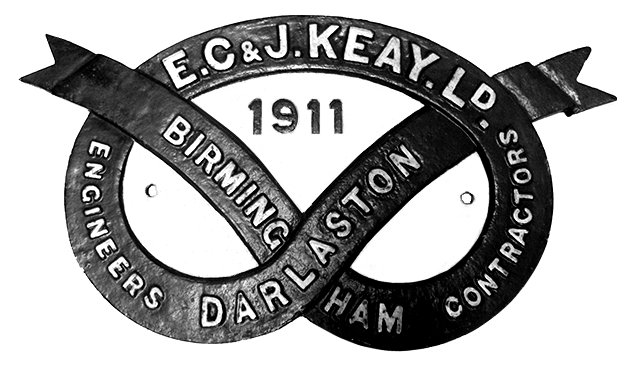
A Keay builder's plate.
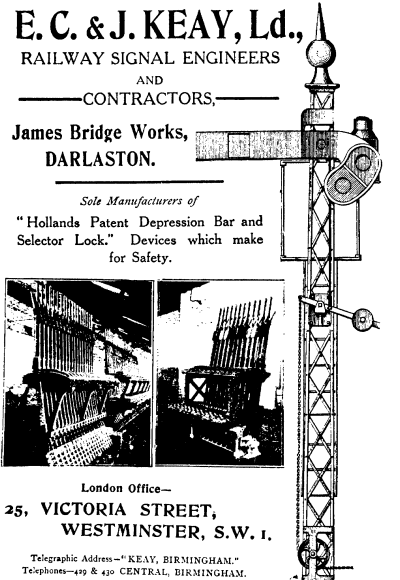 |
In December of that year, the company's property and
assets were put up for sale, and in January 1887 were
acquired by the Keay brothers.
In 1887 Keays moved to
"Bridge Yard", as they called the James Bridge site, and
in June 1888 they purchased an adjacent three acres of
land from Martha Mills and James Slater, along with a
strip of land on the opposite side of Heath Road.
Originally there were no buildings, only open gantries.
E. C. & J. Keay was
incorporated in 1893, and listed in the 1896/1897 Peck's
Trades Directory of Birmingham as makers of steam
boilers. By 1898 the whole business had moved to James
Bridge, and within twelve months the firm added an iron foundry
to the site, for the production of bearings and cast
ironwork.
The firm produced many products over the
years, eventually specialising in structural steelwork
for all types of buildings, such as schools, hospitals,
factories, offices, and warehouses. Bridge Yard had three large
open shops, and good access to the railway, nearby
ironworks and rolling mills. |
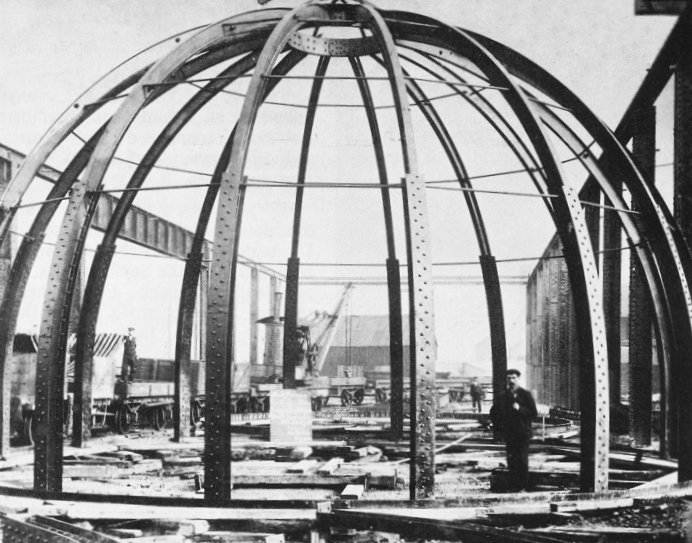
One of the firm's many jobs
before the First World War was the structural steelwork
for the dome of the Victoria and Albert Museum, seen
here at the factory in 1905. Courtesy of Wendy Marston. |
|
Machines included saws, angle
croppers, punches, shears, guillotines, presses,
planers, drilling machines, bending rolls, riveting
machines, and welding machines. In fact everything
needed for the production of structural steelwork. There
were facilities for the trial erection of complicated
structures, and ample storage space for finished
materials, so that deliveries of steel could be phased to
suit erection.
For erection purposes there were
electric scotch derricks, hand cranes, derricks and
winches, mobile cranes, and electric compressors to
provide power on site. Keays undertook the complete
design, fabrication and erection of their structures.
|
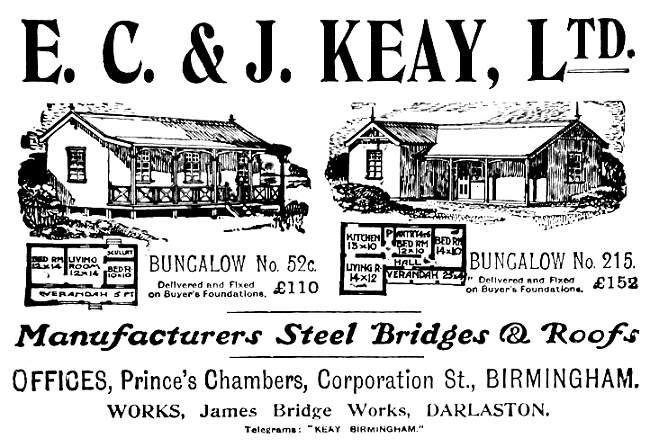 An advert from 1912.
An advert from 1912.
| In 1926 the company went into voluntary
liquidation and was reformed as E. C. & J. Keay
(1926) Limited. |
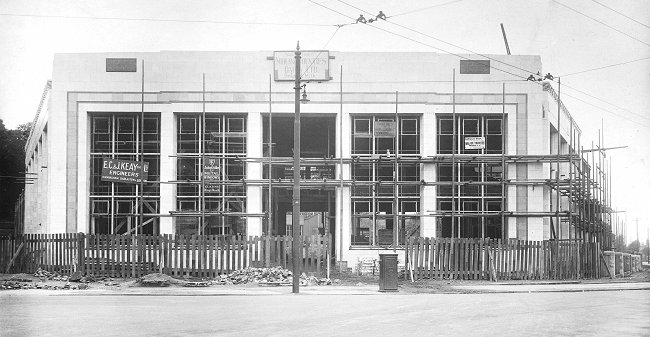
Keays provided the structural
steelwork for the Midland Counties Dairy on the corner
of Lea Road, Wolverhampton. Built in 1930/31. |
| In 1935 the company was wound-up and reformed as
a private limited company: E. C. & J. Keay Limited. |
|
|
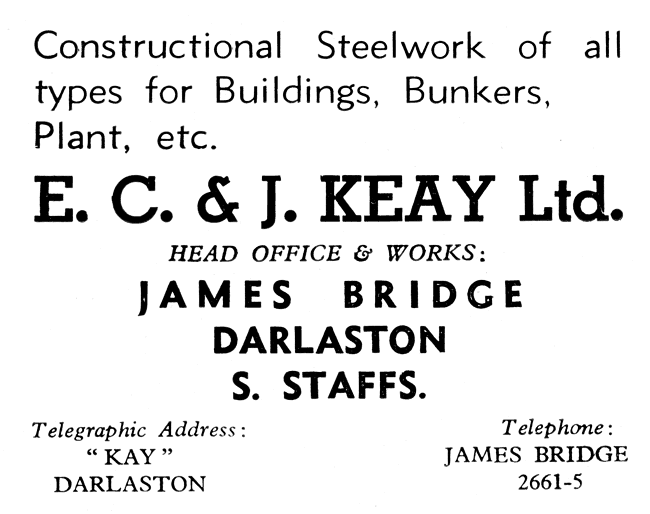
An advert from 1963. |
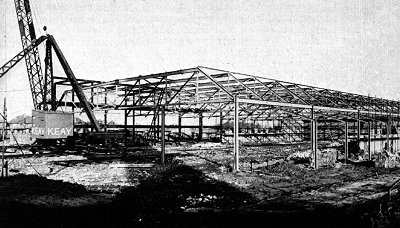 |
The firm provided the steelwork for Birmingham Snow
Hill railway station, which consisted of 6,000 tons of
steel, transported to the site on the firm's Pollen
railway girder wagons. Keays also supplied 1,000 tons of
steelwork for Leicester railway station, the cast iron
pillars used in Kensington High Street Underground
Station, and the steelwork for Neachells No.1 and No.2
power stations, the latter using 8,000 tons of steel.
|
| Other contracts included the Great
Western Hotel at Paddington; Llandudno Railway
Station; large sheds at Southampton Docks; the first
aeroplane hanger at Elmdon; Walsall Technical College;
Typhoo Tea Buildings and Warehouse; Offices at
Birmingham; Midland Counties Dairy at Wolverhampton;
and McKechnie Brothers factory at Aldridge. The firm built many bridges
including Norfolk Bridge at Shoreham-by-Sea; hoppers;
bunkers; railway signalling equipment; the fencing and
gates for Willenhall Memorial Park; also bus depots; and
carried out riveted platework, and welded fabrications.
Structural steelwork was also supplied for building
projects abroad.
In 1957 Keays became a subsidiary
of N. Hingley and Sons, Limited, and in November 1960,
part of the Lloyds Group.
|
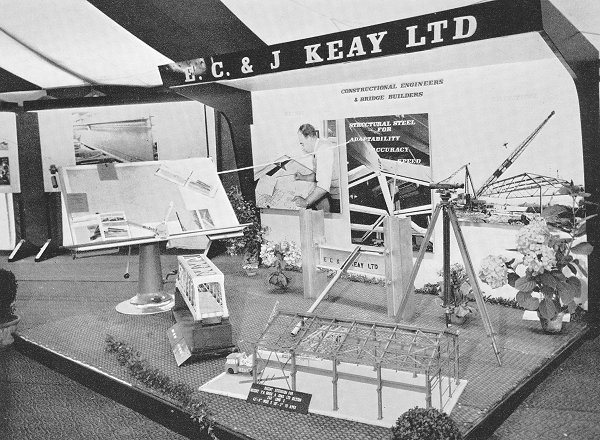
In 1962 Lloyds celebrated British
Steel Foundry Year with a large exhibition at James
Bridge Steelworks. The photograph above is of Keay's
stand at the exhibition. |
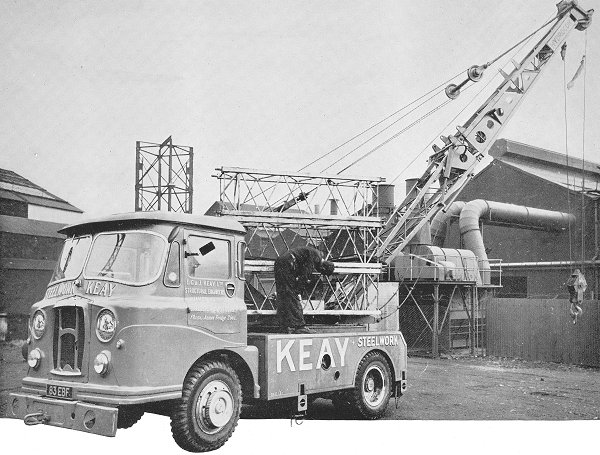 Keay's 'Hydrocon Highlander' 6 ton mobile
crane, acquired in 1962.
Keay's 'Hydrocon Highlander' 6 ton mobile
crane, acquired in 1962.
| 1962 saw the installation of a
54 inch Noble and Lund vertical cold circular sawing
machine, which could cope with the largest sections of
the company's new universal beam range.
It could vertically cut steel
joists of up to 40 inches by 18 inches, at any angle. |
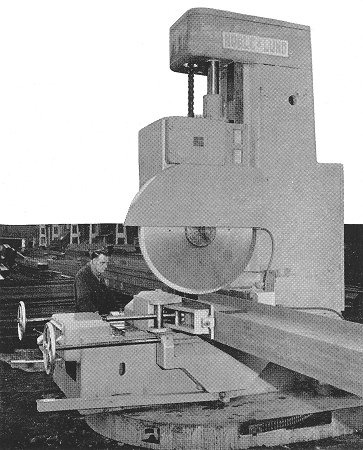 |
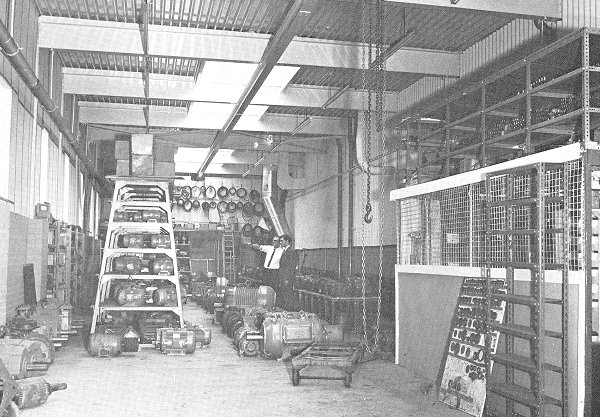
In 1971 Keays designed and built
the new 3,600 square feet storage bay and works canteen
for fellow Lloyds Group member, The Mechanical &
Electrical Engineering Company (Walsall) Limited. |
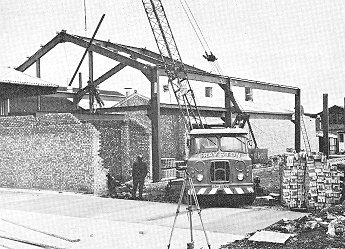 |
|
 |
| A small,
but relatively complex installation took place
in 1971 at George Johnson & Company (Birmingham)
Limited in Shirley. The new building had to be
erected over the top of an existing building
which had to remain in use during the building
work, in order to maintain production. When the
new building had been completed, as seen on the
right, the existing building was demolished.
|
|
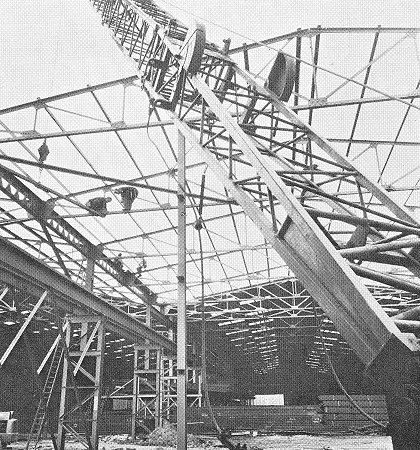 |
The erection of a two-bay
warehouse at Wednesbury in 1971 for Brinton, Adams &
Richards Limited. |
| Another view of the warehouse
during construction. |
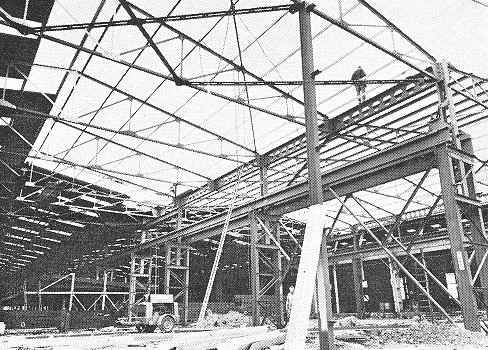 |
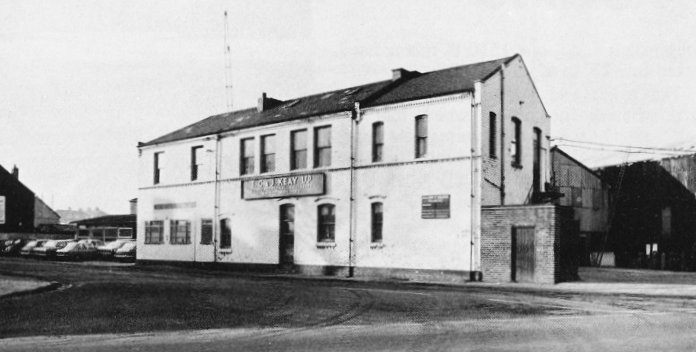
The old office building in
Station Street Darlaston, which was demolished in
1973. Courtesy of Wendy Marston. |
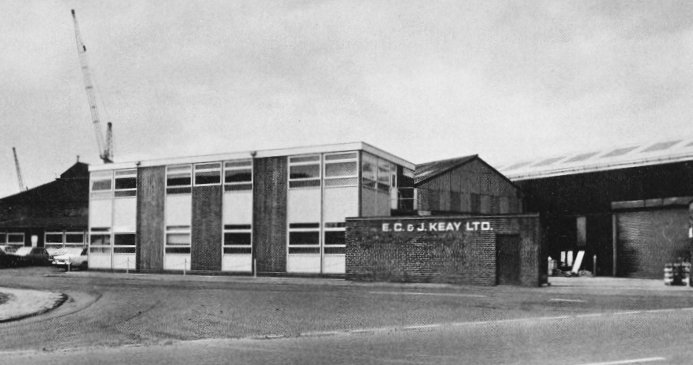
The new main office building
in Station Street, built in 1973 following the
demolition of the old offices. Courtesy of Wendy Marston. |
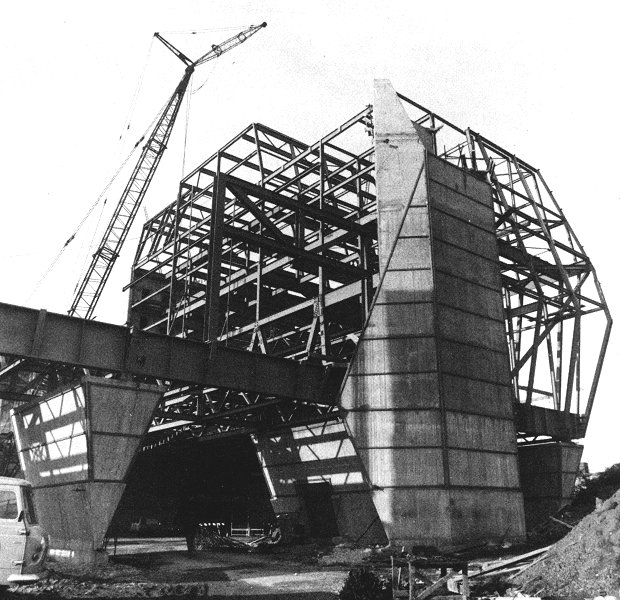 |
Another Keay project, the
steelwork for the Coventry sports complex building.
A contract worth £185,000.
Courtesy of Wendy Marston. |
|
Some of Keay’s projects in the
1970s included the building of the steelwork for a
number of Littlewoods stores, including ones at
Norwich, Harrow, Lewisham, Truro, West Bromwich,
Worcester, Kidderminster and Corby. Other projects
include steelwork for the following:
The Incinerator
Building at City of Stoke-on-Trent.
A number of 200
ft. high flare towers for North Sea oil rigs.
Manchester
United Football Club including some large Cantilever
girders.
A continuous
casting platform for Round Oak Steelworks.
In 1975 the company installed a
computer to provide "instant designs" of portal
frame structures. A special program was written to enable Keays to increase their activities
in the supplying of supporting structures for water
tanks made by Brown Lenox (London). |
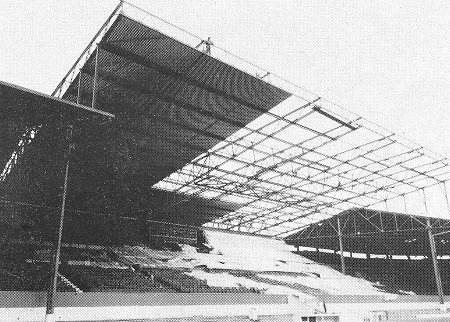 |
In 1975 Keays built a new roof
covering one of the stands at Manchester United's football
ground, Trafford Park. It involved nine 160 ft. long lattice
girders, each weighing nine tons. |
 |
Return to the
previous page |
|



